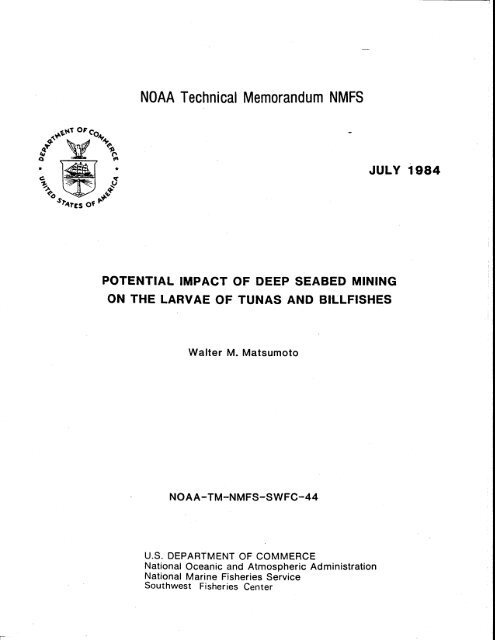NOAA Technical Memorandum NMFS JULY 1984 - Pacific Islands ...
NOAA Technical Memorandum NMFS JULY 1984 - Pacific Islands ...
NOAA Technical Memorandum NMFS JULY 1984 - Pacific Islands ...
Create successful ePaper yourself
Turn your PDF publications into a flip-book with our unique Google optimized e-Paper software.
37<br />
These figures would be about four times larger if the m1n1ng ship were to<br />
act as a FAD by concentrating tuna schools in the immediate vicinity of the<br />
mining ship. Spawning activities by these schools could increase the<br />
concentration of eggs near the mining ship. Such increases can easily be<br />
threefold or fourfold greater than the concentration in nonmining<br />
situations.<br />
The impact of the mortality estimated above on the eastern <strong>Pacific</strong><br />
northern fishery (north of lat. lSON) and on the Hawaiian skipjack tuna<br />
fishery can be estimated. In the eastern <strong>Pacific</strong>, practically all of the<br />
fish entering the northern fishery originate in equatorial waters west of<br />
long. l30 o W. Larvae from this region are transported eastward in the NECC<br />
and enter the fishery as l-year-old fish. Fish of this age group comprise<br />
24% by weight (2,336 MT) of the skipjack tuna and 0.9% (2,235 MT) of the<br />
yellowfin tuna taken annually in the northern fishery (average annual<br />
catches estimated for the period 1971-74). Of the estimated number of<br />
larvae that would likely be killed by mining (45,700 skipjack tuna and<br />
14,700 yellowfin tuna), 80% are expected to die of natural causes, leaving<br />
9,900 skipjack tuna and 2,940 yellowfin tuna (equivalent to 15.3 and 10.7<br />
MT, respectively) to survive and enter the fishery as l-year-old fish.<br />
Adjusting for possible FAD-like effects of the mining ship would increase<br />
the totals to 65.2 and 42.8 MT for skipjack and yellowfin tunas,<br />
respectively. These totals, representing approximately 0.64 and 0.16% of<br />
the annual catches of skipjack and yellowfin tunas, respectively, should<br />
have no noticeable effect on the total annual catches of both species taken<br />
in the eastern <strong>Pacific</strong> northern fishery.<br />
In the Hawaiian fishery, the impact of mining on the skipjack tuna<br />
fishery would be even less, since the species also spawns in the fishing<br />
grounds, outside of the projected mining area (i.e., north of lat. 20 0 N).<br />
Larvae from these spawnings could remain in the area and be subjected to<br />
fishing a year later (as l-year-olds) or migrate south into the mining area<br />
in winter as juveniles, at sizes large enough to withstand the impact of<br />
m1n1ng, and return as l-year-old fish in the summer, together with fish<br />
spawned within the mining area.<br />
Based on this study, the probable effects of mining on tuna and<br />
billfish eggs and larvae appear to be negligible; however, the premises on<br />
which certain deductions have been made, require verification. Laboratory<br />
studies to accurately describe the effects of sediment and temperature on<br />
tuna eggs and larvae and On the spawning behavior of adult tunas need to be<br />
made. In the field, more detailed observations on the temperature of the<br />
water at the point of discharge are needed and the effect of the discharge<br />
water on tuna eggs and larvae at the point of mixing need to be determined.<br />
The abundance of tuna and billfish eggs and larvae along the path of the<br />
m1n1ng ship needs to be determined routinely, so that the extent of the<br />
damage to these life stages can be monitored. If damage to the eggs and<br />
larvae by the discharge is found to be excessive, then alteration of the<br />
discharge point, perhaps to subsurface levels, may be necessary.<br />
Aside from these studies concerning direct effects on eggs and larvae,<br />
additional studies are needed on the pelagic food web. It is recommended<br />
that the effects of sediment and temperature on all components in the food<br />
web be studied, particularly those organisms which are consumed during<br />
initial feeding by the larvae.


